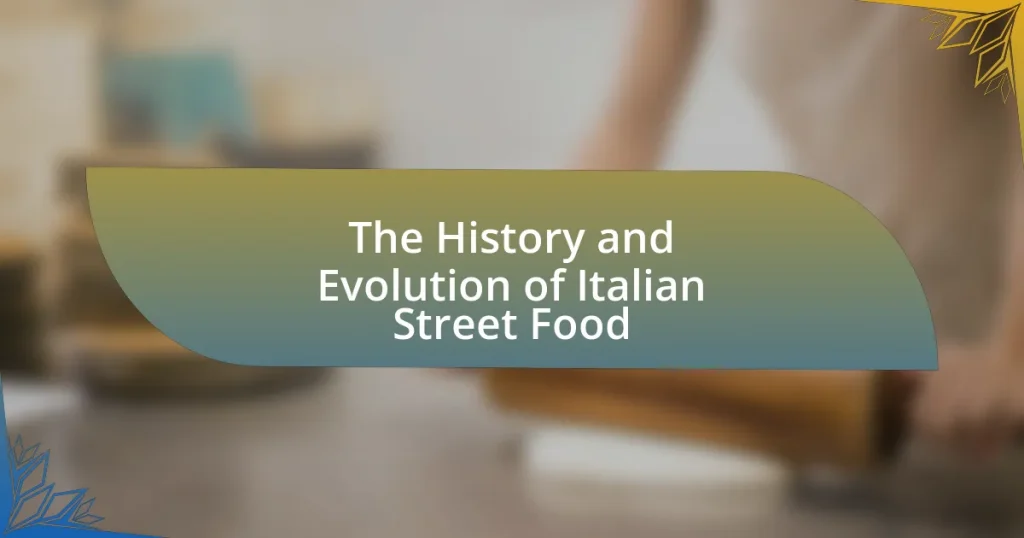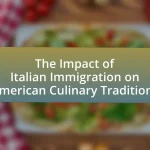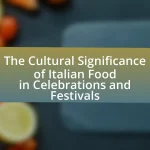The article explores the history and evolution of Italian street food, tracing its origins back to ancient Rome where vendors provided simple meals to the working class. It highlights the cultural influences that shaped early street food, including Roman, Arab, and regional Italian traditions, and discusses the role of street food in local communities and economies. The article also examines how street food has evolved over time, influenced by historical events, immigration, and modern trends, leading to the diverse offerings available today, such as pizza al taglio and arancini. Additionally, it addresses health and safety standards for vendors and provides insights on how to experience authentic Italian street food.

What is the history of Italian street food?
Italian street food has a rich history that dates back to ancient Rome, where vendors sold simple foods like bread, cheese, and olives to the working class. Over centuries, this tradition evolved, influenced by regional ingredients and culinary practices. In the Middle Ages, street food became more diverse with the introduction of fried foods and pastries, reflecting local agricultural products. By the 19th century, the industrial revolution further transformed street food culture, as urbanization led to an increase in food vendors offering quick, affordable meals to the growing population. Today, Italian street food includes iconic items such as pizza al taglio, arancini, and gelato, showcasing the country’s culinary heritage and regional flavors.
How did Italian street food originate?
Italian street food originated from the necessity of providing quick, affordable meals to workers and travelers in urban areas. Historically, vendors sold simple, portable foods like focaccia, pizza, and fried snacks, which were easy to prepare and consume on the go. The tradition can be traced back to ancient Rome, where street food was common, and it evolved through the Middle Ages as cities grew and the demand for convenient food options increased. This evolution was influenced by regional ingredients and culinary practices, leading to a diverse array of street food offerings across Italy.
What cultural influences shaped the early forms of Italian street food?
The early forms of Italian street food were shaped by various cultural influences, including Roman, Arab, and regional Italian traditions. Roman street food, such as puls (a type of porridge), laid the groundwork for quick, accessible meals. The introduction of spices and cooking techniques from Arab traders during the Middle Ages influenced the use of ingredients like saffron and citrus in street food. Additionally, regional variations emerged as local ingredients and customs were incorporated, leading to diverse offerings like pizza in Naples and arancini in Sicily. These influences collectively contributed to the rich tapestry of Italian street food, reflecting the country’s historical interactions and culinary evolution.
What were the common ingredients used in traditional Italian street food?
Common ingredients used in traditional Italian street food include bread, cheese, tomatoes, olive oil, and various meats. Bread serves as a base for many dishes, such as panini and focaccia, while cheese, particularly mozzarella and ricotta, adds flavor and texture. Tomatoes are essential in sauces and toppings, contributing to dishes like pizza and arancini. Olive oil is a staple for cooking and dressing, enhancing the overall taste. Various meats, including prosciutto and sausages, are often featured in street food items, providing protein and richness. These ingredients reflect Italy’s culinary heritage and regional diversity, making them integral to the street food experience.
What role did Italian street food play in local communities?
Italian street food served as a vital social and economic connector within local communities. It provided accessible, affordable meals for working-class individuals and families, fostering communal gatherings and interactions. Historically, vendors often set up stalls in public spaces, creating hubs for socialization and cultural exchange, particularly in urban areas like Naples and Palermo. This practice not only supported local economies by generating income for small businesses but also preserved culinary traditions, as recipes and cooking methods were passed down through generations, reinforcing community identity and heritage.
How did street food vendors contribute to the economy?
Street food vendors significantly contributed to the economy by creating jobs, stimulating local businesses, and generating tax revenue. These vendors often employ individuals from their communities, providing essential income and reducing unemployment rates. For instance, in Italy, street food markets have become vital for local economies, with thousands of vendors operating in urban areas, contributing to the livelihood of many families. Additionally, street food vendors support local suppliers and farmers by sourcing ingredients locally, which further stimulates economic activity within the region. According to a report by the Italian National Institute of Statistics, the street food sector has seen a growth rate of approximately 10% annually, highlighting its importance in the overall economic landscape.
What social functions did street food serve in Italian culture?
Street food in Italian culture served as a vital social function by facilitating community interaction and cultural exchange. It acted as a communal dining experience, where people gathered in public spaces to enjoy meals together, fostering social bonds. Historically, street vendors provided affordable and accessible food options, allowing diverse social classes to share culinary experiences. For instance, during festivals and markets, street food became a focal point for social gatherings, enhancing local traditions and cultural identity. This practice has roots in ancient Roman times, where food stalls were common in public areas, illustrating the long-standing role of street food in promoting social cohesion within Italian communities.

How has Italian street food evolved over time?
Italian street food has evolved significantly from its origins in ancient Rome, where vendors sold simple fare like bread and cheese, to a diverse array of offerings reflecting regional ingredients and culinary traditions. Over time, the introduction of new ingredients, such as tomatoes and spices from the Americas, transformed traditional dishes, leading to the creation of iconic street foods like pizza and arancini. The rise of food trucks and modern markets in the 20th century further diversified street food options, incorporating international influences and gourmet twists, making it a vibrant part of contemporary Italian culture.
What major historical events influenced the evolution of Italian street food?
The evolution of Italian street food has been significantly influenced by several major historical events, including the Roman Empire’s expansion, the Renaissance, and the post-World War II economic boom. The Roman Empire facilitated the exchange of culinary practices across its territories, introducing diverse ingredients and cooking methods that shaped local street food. During the Renaissance, urbanization and the rise of markets led to increased accessibility of food vendors, promoting the popularity of quick, affordable meals. The post-World War II economic boom further transformed street food culture as people sought convenient dining options amidst rapid urban growth and changing lifestyles, leading to the proliferation of food stalls and trucks across Italian cities.
How did immigration impact the types of street food available in Italy?
Immigration significantly diversified the types of street food available in Italy by introducing various culinary traditions and ingredients from different cultures. For instance, the influx of immigrants from North Africa and the Middle East brought dishes such as kebabs and falafel, which have become popular in urban areas. Additionally, the arrival of Eastern European immigrants introduced foods like pierogi and various pastries, enriching the street food landscape. Historical data shows that cities like Rome and Milan have seen a rise in food stalls offering international cuisine, reflecting the multicultural influences that immigration has had on local food scenes.
What technological advancements changed the preparation and distribution of street food?
Technological advancements such as mobile food trucks, online ordering platforms, and food preservation techniques have significantly changed the preparation and distribution of street food. Mobile food trucks allow vendors to reach diverse locations, increasing accessibility and customer base. Online ordering platforms, like food delivery apps, enable customers to order street food conveniently from their smartphones, enhancing distribution efficiency. Additionally, advancements in food preservation, such as vacuum sealing and refrigeration, have improved food safety and extended the shelf life of ingredients, allowing for fresher offerings in street food. These innovations collectively contribute to a more dynamic and accessible street food culture.
How have modern trends affected Italian street food?
Modern trends have significantly transformed Italian street food by introducing innovative flavors, fusion cuisines, and a focus on sustainability. The rise of food trucks and gourmet street food vendors has led to a diversification of traditional offerings, incorporating global influences while maintaining authentic Italian roots. For instance, the popularity of artisanal ingredients and organic produce has prompted vendors to prioritize quality and local sourcing, aligning with contemporary consumer preferences for healthier and environmentally friendly options. Additionally, social media has played a crucial role in promoting street food culture, allowing vendors to reach wider audiences and create visually appealing dishes that attract customers. This evolution reflects a broader shift in dining habits, where convenience and unique culinary experiences are increasingly valued.
What fusion cuisines have emerged in contemporary Italian street food?
Contemporary Italian street food has seen the emergence of various fusion cuisines, notably Italian-Mexican and Italian-Asian combinations. Italian-Mexican fusion includes dishes like tacos filled with traditional Italian ingredients such as porchetta or arancini, while Italian-Asian fusion features items like sushi rolls incorporating Italian flavors, such as pesto or mozzarella. These innovations reflect a growing trend where traditional Italian street food is reimagined through the lens of other culinary traditions, appealing to diverse palates and enhancing the street food experience.
How has the rise of food trucks transformed the street food scene in Italy?
The rise of food trucks has significantly transformed the street food scene in Italy by introducing diverse culinary options and enhancing accessibility. Food trucks have allowed chefs and entrepreneurs to offer innovative dishes that blend traditional Italian flavors with international influences, catering to a broader audience. This shift has been supported by the growing popularity of food festivals and markets, where food trucks serve as key attractions, showcasing regional specialties and gourmet street food. Additionally, the mobility of food trucks enables them to reach various urban and rural locations, increasing the availability of street food across Italy. This transformation reflects a shift in consumer preferences towards casual dining experiences and artisanal food, contributing to a vibrant and evolving street food culture in the country.

What are the most popular types of Italian street food today?
The most popular types of Italian street food today include pizza al taglio, arancini, and panzerotti. Pizza al taglio, or “pizza by the slice,” is characterized by its rectangular shape and variety of toppings, making it a convenient option for on-the-go eating. Arancini are fried rice balls typically filled with ragù, mozzarella, or peas, originating from Sicily and widely enjoyed across Italy. Panzerotti, which are small, stuffed pastries often filled with tomato and mozzarella, are particularly popular in southern Italy. These street foods reflect regional culinary traditions and have gained popularity due to their flavor, portability, and cultural significance in Italian cuisine.
What are the signature dishes of Italian street food?
The signature dishes of Italian street food include Arancini, which are rice balls filled with various ingredients and deep-fried, and Pizza al Taglio, a rectangular pizza sold by weight. Additionally, Panzerotti, which are fried or baked pastries filled with cheese and tomato, and Frittata di Pasta, a pasta omelet, are also popular. These dishes reflect regional ingredients and culinary traditions, showcasing Italy’s diverse food culture. For instance, Arancini originated in Sicily and are often filled with ragù, while Pizza al Taglio is a staple in Rome, highlighting the local preference for thicker crusts.
How do regional variations influence the types of street food found in Italy?
Regional variations significantly influence the types of street food found in Italy by reflecting local ingredients, culinary traditions, and cultural practices. For instance, in Naples, street food prominently features pizza, particularly the iconic Neapolitan pizza, which utilizes local San Marzano tomatoes and mozzarella di bufala. In contrast, Sicilian street food includes arancini, rice balls filled with various ingredients, showcasing the island’s agricultural products and Arab culinary influences. Additionally, in Bologna, the focus is on tortellini and piadine, which highlight the region’s rich pasta-making heritage. These regional specialties demonstrate how local resources and historical influences shape the diverse landscape of Italian street food.
What are the most common preparation methods for popular street food items?
The most common preparation methods for popular street food items include frying, grilling, steaming, and baking. For instance, Italian street food like arancini (fried rice balls) is typically deep-fried, while panini (grilled sandwiches) are made using a grill or press. Additionally, foods such as focaccia are often baked, and dumplings may be steamed. These methods are prevalent due to their ability to enhance flavors and textures, making them ideal for quick, on-the-go consumption.
What are the health and safety standards for Italian street food vendors?
Health and safety standards for Italian street food vendors require compliance with local food safety regulations, including proper food handling, storage, and sanitation practices. Vendors must ensure that food is prepared in hygienic conditions, maintain appropriate temperatures for hot and cold foods, and use safe water sources for cooking and cleaning. Additionally, they must obtain necessary permits and undergo regular health inspections to verify adherence to these standards. In Italy, the Ministry of Health and local health authorities enforce these regulations, ensuring that vendors meet specific criteria to protect public health.
How do regulations vary across different regions in Italy?
Regulations regarding street food in Italy vary significantly across different regions due to local laws, cultural practices, and health standards. For instance, in regions like Emilia-Romagna, street food vendors must adhere to strict hygiene regulations and obtain specific permits, reflecting the area’s emphasis on food quality and safety. Conversely, in regions such as Sicily, regulations may be more lenient, allowing for a vibrant street food culture that emphasizes traditional recipes and local ingredients. This regional variation is influenced by historical factors, such as the culinary heritage of each area, and the local government’s approach to food entrepreneurship, which can either promote or restrict street food activities.
What best practices should vendors follow to ensure food safety?
Vendors should follow strict hygiene practices, including regular handwashing, to ensure food safety. Maintaining clean workspaces, using sanitized utensils, and storing food at appropriate temperatures are essential steps. Additionally, vendors must source ingredients from reputable suppliers and ensure that food is cooked to safe temperatures to eliminate harmful bacteria. According to the Food and Drug Administration (FDA), proper food handling can significantly reduce the risk of foodborne illnesses, which affect millions annually.
How can one experience authentic Italian street food?
To experience authentic Italian street food, one should visit local markets and food festivals in Italy, where traditional vendors offer regional specialties. Engaging with street food in cities like Naples, Rome, and Bologna allows individuals to taste iconic dishes such as pizza al taglio, supplì, and arancini, which reflect the culinary heritage of the area. Historical records indicate that street food has been a part of Italian culture since ancient times, with vendors selling ready-to-eat meals to workers and travelers, thus ensuring that the experience remains deeply rooted in local traditions.
What tips can travelers follow to find the best street food in Italy?
Travelers can find the best street food in Italy by seeking out local markets, food stalls, and popular eateries frequented by residents. Local markets, such as Mercato di Testaccio in Rome or Mercato Centrale in Florence, offer authentic regional dishes and a vibrant atmosphere. Food stalls that have long lines often indicate quality and popularity, as locals tend to gravitate towards the best options. Additionally, exploring neighborhoods known for their culinary heritage, such as Naples for pizza or Palermo for arancini, can lead to discovering iconic street foods. Engaging with locals for recommendations can also enhance the experience, as they often know hidden gems that may not be widely advertised.
How can locals support street food vendors in their communities?
Locals can support street food vendors in their communities by purchasing their food regularly, which directly contributes to the vendors’ income and sustainability. Frequent patronage helps vendors maintain their businesses and encourages the diversity of food options available. Additionally, locals can promote these vendors through word-of-mouth and social media, increasing their visibility and customer base. Supporting local street food vendors not only fosters community ties but also preserves cultural culinary traditions, as seen in the rich history of Italian street food, which has evolved through generations and reflects regional flavors and ingredients.















